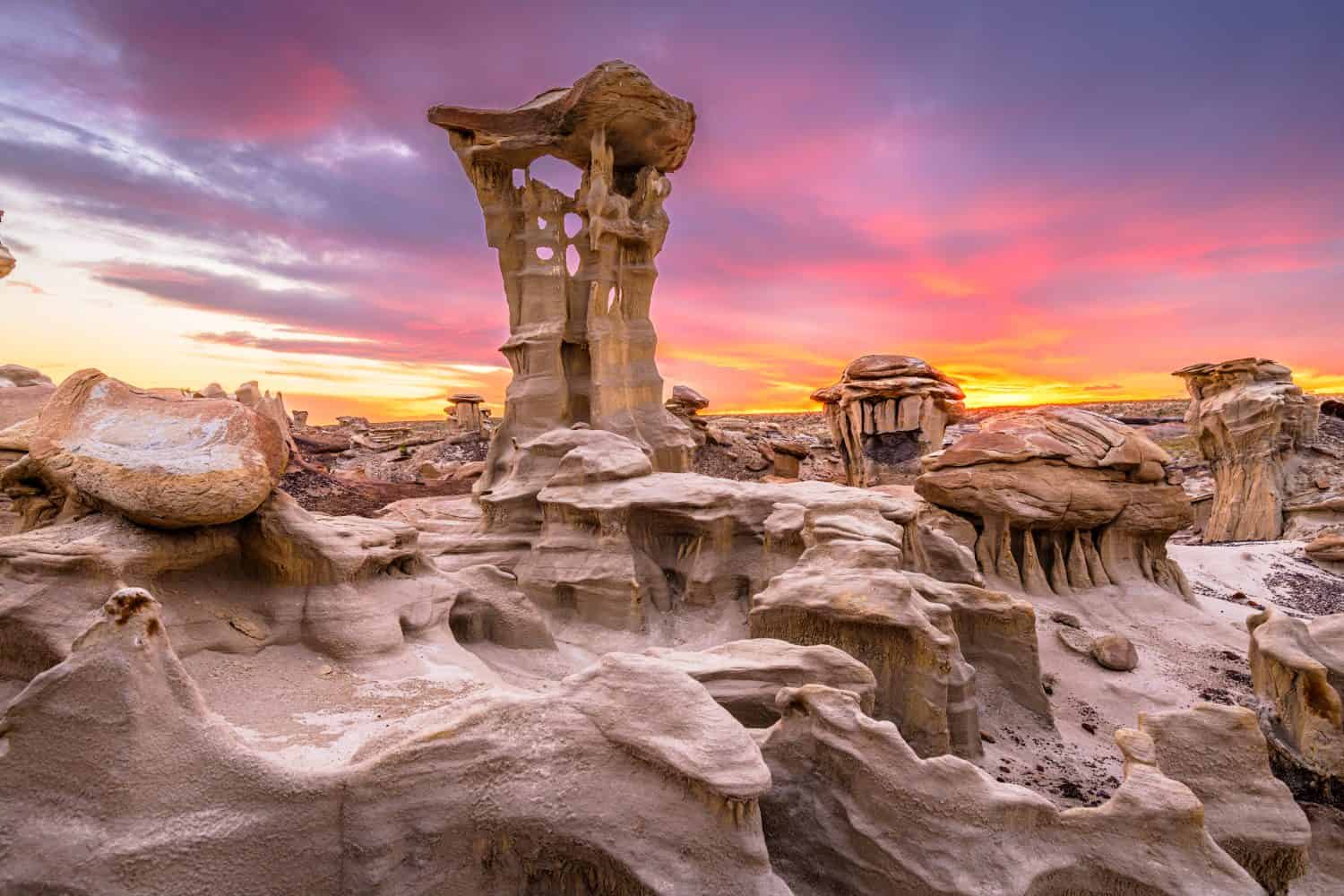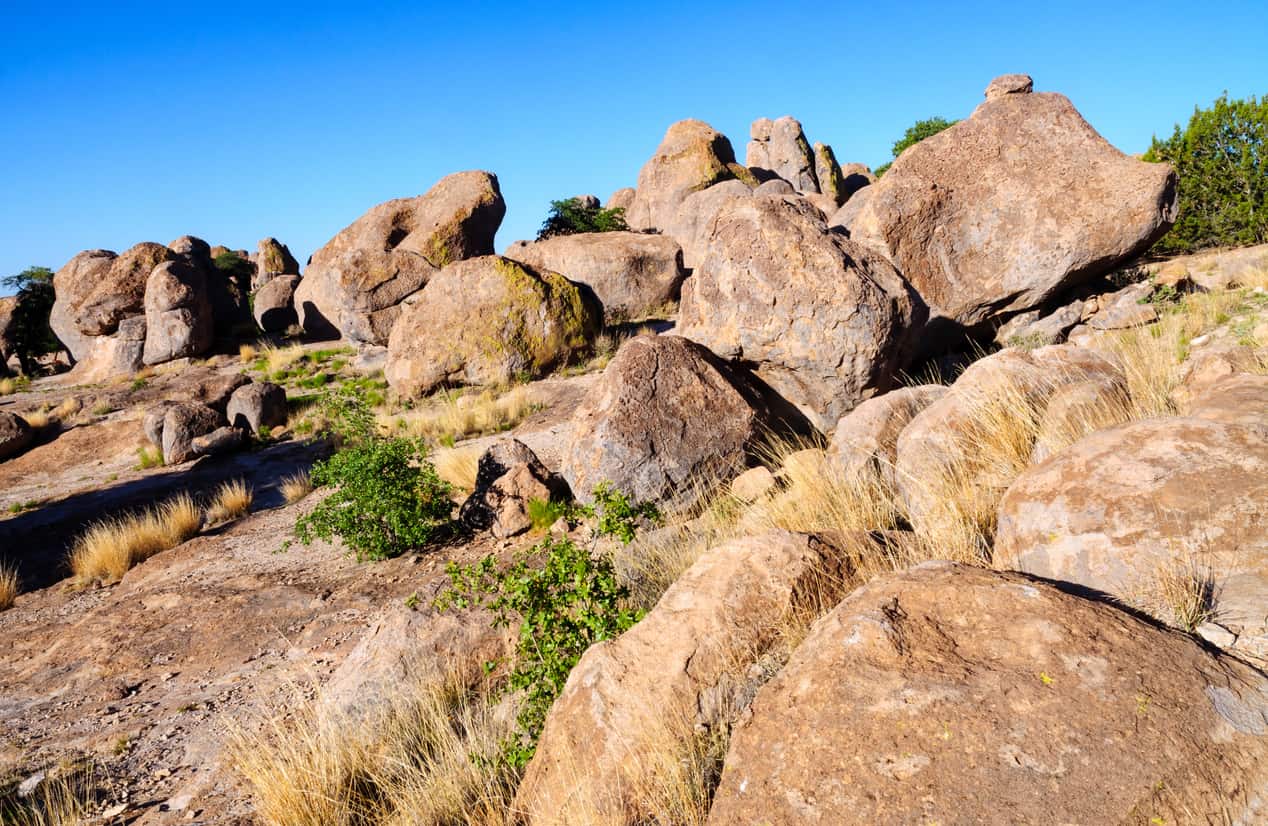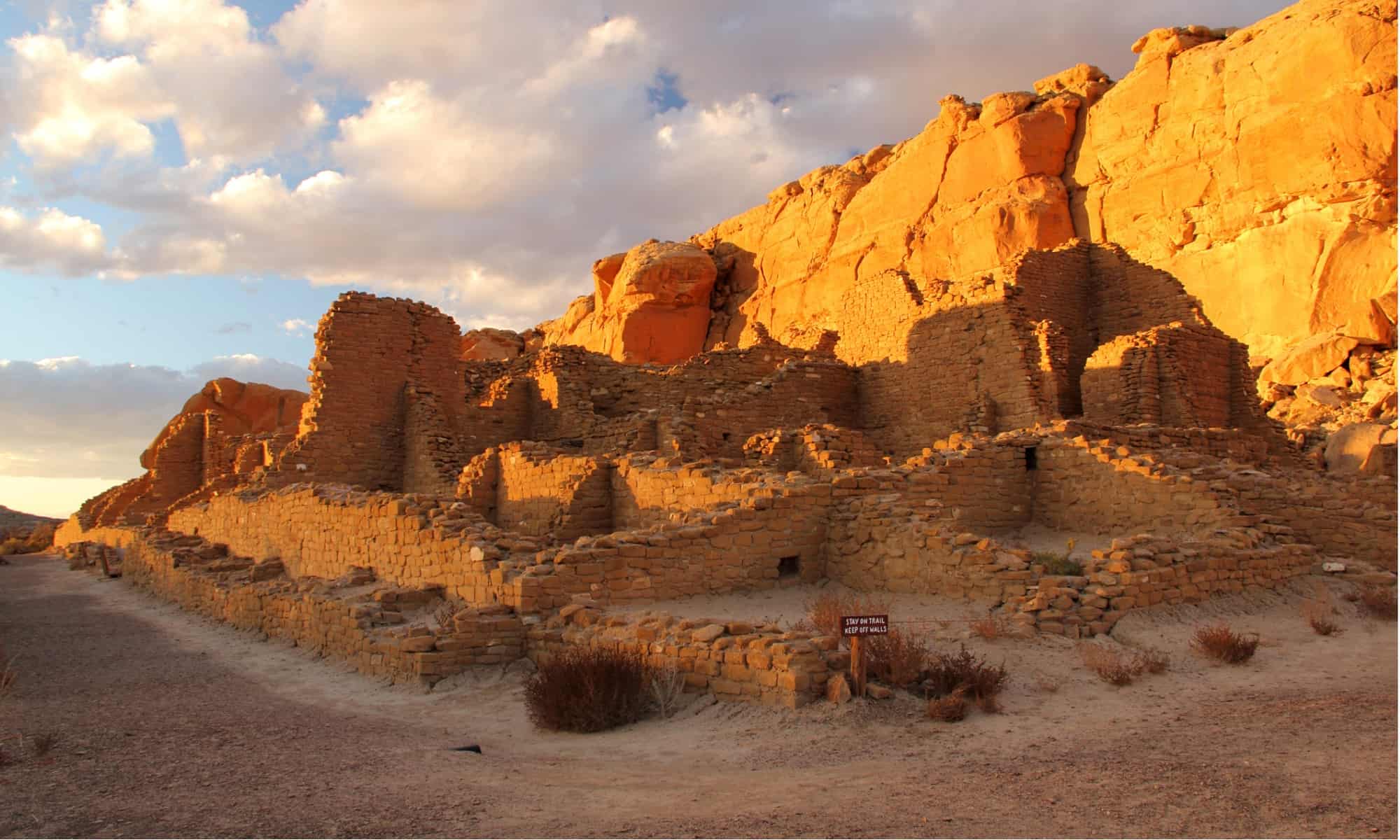The Land of Enchantment, New Mexico’s nickname, became the 47th state in the union in 1912 and is 121,590 mi2. As a result, it is the fifth largest state in America. New Mexico is celebrated for its unique attractions, art, culture, and landscapes. Continue reading to discover the 11 most remote spots in New Mexico and how to safely get there.
Karl G. Jansky Very Large Array (VLA)

Astronomers the world over listen to the universe!
©Sarmiento Photography/Shutterstock.com
This remote location 50 miles west of Socorro is perfect for astronomers who chose the Plains of San Austin for their array of radio dishes used for satellite tracking, weather and atmospheric studies, and other scientific monitoring. Far from major cities, indeed radio interference is not a problem. Desert conditions are ideal as humidity is problematic in radio astronomy because water molecules distort and give off radio waves. Built between 1973 and 1980 it is the world’s most powerful radio telescope. For instance, each antenna, there are 28, has an 82-foot dish and each dish has eight receivers. As a result, astronomers the world over listen to the universe! Visitors are welcome.
Shiprock

The Navajo call it “Tsé Bit’ a’í”, or rock with wings.
©Bowie Snodgrass, CC BY 2.0, via Wikimedia Commons - License
This 1,400-foot towering rock formation 7,178 feet above sea level is fifteen miles southwest of the town of Shiprock in remote northwestern New Mexico. The Navajo refer to it as “Tsé Bit’ a’í”, or rock with wings. Shiprock comes from its resemblance to a 19th-century clipper ship. Legend has it that a great bird brought the Navajo people from the north to this place. However, hiking, climbing, or driving on the road to this seldom-seen internal volcanic structure is not permitted. And this sacred place is viewed only from the highway.
Sitting Bull Falls

A 250-million-year-old inland sea once existed here.
©IrinaK/Shutterstock.com
This oasis in the desert is a series of 150-foot spring-fed waterfalls that end in a large pool. Caves exist behind the falls, however they require a guided tour. Located 42 miles west of Carlsbad in the Lincoln National Forest this park is at an elevation of 5,000 feet above sea level with 16 miles of hiking trails. Indeed the area around the falls dates back to the Permian period, the remnants of a reef system called the Capitan Great Barrier Reef. Here is where a 250-million-year-old inland sea once existed. In addition, wildlife is abundant here and includes snakes, coyotes, wolves, mountain lions, desert mice, prairie dogs, rabbits, and many birds.
Sugarite Canyon State Park

Part of the Dry Cimarron Scenic Byway, this area is flanked by old lava flows, cone-shaped volcanoes, mesas, and cliffs.
©M.J. Howard/Shutterstock.com
Located in the remote northeastern region near the Colorado border, the Rocky Mountains, and the Great Plains this park is six miles northeast of Raton. Park elevation here is 6,950 feet above sea level on 3,600 acres. Flanked by old lava flows, cone-shaped volcanoes, mesas, and cliffs it is part of the Dry Cimarron Scenic Byway. In fact, within the park are the ruins of an abandoned mining camp. Once the home to Apache, Ute, and Comanche tribes and active cattle ranches in the 1800s. Wildlife is abundant including little brown bats, rabbits, skunks, weasels, porcupines, raccoons, and black bears. In addition, activities here include camping, hunting, horseback riding, hiking, boating, and fishing.
Clayton Lake State Park

Over 800 dinosaur footprints are visible from the overlook at Clayton Lake Dam.
©Danielle Hunt/Shutterstock.com
Interested in dinosaurs? Here is where the most extensive dinosaur trackways in North America exist. For example, over 800 footprints are visible below the overlook at Clayton Lake Dam. At an elevation of 5,040 feet above sea level, this remote park offers a lot of fun activities as well as a glimpse into the past. Covering 170 acres it is located 15 miles north of Clayton near the borders of Texas, Oklahoma, and Colorado in remote northeastern New Mexico. Additionally, the fishing season runs from March to October when trout, walleye, bass, and catfish are abundant.
Bisti/De-Na-Zin Wilderness

Bisti translates from Navajo to mean “a large area of shale hills” and De-Na-Zin means “cranes.”
©Sean Pavone/Shutterstock.com
This rolling landscape of badlands is rich in fossil beds and covers 45,000 acres with some of the most unique scenery in the region. Bisti translates from Navajo to mean “a large area of shale hills” and De-Na-Zin means “cranes.” This desolate wilderness near Bloomfield and about 40 miles south of Farmington is closed to motorized vehicles. Additionally, while visiting collecting fossils or climbing on geologic formations is prohibited. Guided tours are recommended because there are no marked trails. Wildlife in the area includes prairie dogs, porcupines, badgers, and cottontail rabbits. In addition, there are nesting golden eagles, prairie falcons, and ferruginous hawks during February through July, please do not disturb them.
Villanueva State Park

The park is surrounded by yellow and red sandstone cliffs.
©Laurens Hoddenbagh/Shutterstock.com
Located between high sandstone bluffs along the Pecos River this park is near the Spanish-colonial village of Villanueva. Located on NM Highway 3 between I-40 and I-25 at an elevation of 6,110 feet above sea level it offers 2.9 miles of trails, hiking, birding, fishing, boating, camping, and swimming. Surrounded by yellow and red sandstone cliffs, cottonwood trees, and a variety of native plants, indeed this is a breathtaking place to relax! In addition, anglers can enjoy catching catfish and brown and rainbow trout.
Cimarron Canyon State Park

Several waterfalls can be seen along the trails here.
©Traveller70/Shutterstock.com
This narrow-forested canyon is eight miles in length between Ute Park and Tolby Creek and three miles east of Eagle Nest on Highway 64. It is part of the Colin Neblett Wildlife Area and is 378 acres at an elevation of 7,500 feet above sea level. Indeed, there are breathtaking views here as well as activities such as camping, fly fishing, hiking, or horseback riding. Several waterfalls exist along the trails and wildlife in the area includes turkey, bear, elk, and deer. In addition, trout fishing is a popular sport.
Bottomless Lakes State Park

These unique lakes are indeed sinkholes ranging in depth from 17 to 90 feet.
©Trina Barnes/Shutterstock.com
For something a bit unusual, go 14 miles southeast of Roswell, think UFOs, to these unique lakes that are, indeed, sinkholes ranging in depth from 17 to 90 feet. Aquatic plants create the greenish-blue hues giving the illusion of depth. Park elevation is 3,617 feet above sea level on the east edge of the Pecos River on 1,611 acres. It is a place of legends, one being that a large turtle roams the bottom of one of the sinkholes. Lea Lake which is 90-foot-deep is the only place to swim. In addition, four endangered species exist here, the eastern barking frog, the cricket frog, the rainwater killifish, and the Pecos pupfish.
City of Rocks State Park

These rock formations occurred about 34 million years ago during a volcanic eruption.
©iStock.com/zrfphoto
In the Chihuahuan desert in remote southwestern New Mexico is the City of Rocks State Park. The elevation here is 5,259 feet above sea level with an area of 1,230 acres. This ancient geologic formation of large sculpted rock columns created during a volcanic eruption nearly 34 million years ago rises as high as 40 feet. Located between Deming and Silver City, this park offers a desert botanical garden, mountain biking, hiking trails, and campgrounds. Additionally, bird species here include blue grosbeak, great-horned owl, common poorwill, and lesser nighthawk.
Chaco Culture National Historic Park

The Chacoan people lived here between 850 and 1250 AD.
©iStock.com/Wilsilver77
Located in a remote canyon in northwestern New Mexico between Farmington and Albuquerque is Chaco Culture National Historic Park at an elevation of 6,200 feet with an area of 53.09 mi2. Included within the Chaco Culture National Historical Park World Heritage Site is the Aztec Ruins National Monument. Chacoan people lived here between 850 and 1250 AD. Get a glimpse into what the Chaco culture was like from these well-preserved archeological remains. However, access is only by dirt roads while traveling through private tribal lands. Additionally, wildlife in the area includes lizards, antelope ground squirrels, kangaroo rats, prairie dogs, jackrabbits, bobcats, and coyotes.
Discover the 11 Most Remote Spots in New Mexico and How to Safely Get There
| Name | Location |
|---|---|
| Karl G. Jansky Very Large Array (VLA) | Near Socorro |
| Shiprock | Near the town of Shiprock |
| Sitting Bull Falls | West of Carlsbad |
| Sugarite Canyon State Park | Northeast of Raton |
| Clayton Lake State Park | North of the town of Clayton |
| Bisti/De-Na-Zin Wilderness | Near Bloomfield |
| Villanueva State Park | Near the town of Villanueva |
| Cimarron Canyon State Park | East of Eagle Nest |
| Bottomless Lakes State Park | Southeast of Roswell |
| City of Rocks State Park | Between Deming and Silver City |
| Chaco Culture National Historic Park | Between Farmington and Albuquerque |
The photo featured at the top of this post is © rarrarorro/iStock via Getty Images
Thank you for reading! Have some feedback for us? Contact the AZ Animals editorial team.







